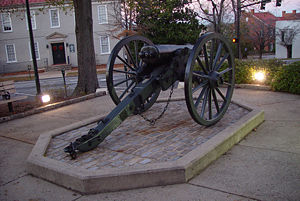Double-barreled cannon
The double-barreled cannon is an American Civil War-era experimental weapon and is now a modern landmark located in Athens, Georgia.
He cast the first cannon with the intention of simultaneously firing two balls linked by a chain from side-by-side barrels, which were meant to scythe down enemy soldiers like standing wheat when it reached them.
Cast in one piece, the gun featured side-by-side bores, each a little over 3 inches in diameter and splayed slightly outward so the shots would diverge and stretch the chain taut.
The two barrels have a divergence of 3 degrees, and the cannon was designed to shoot simultaneously two cannonballs connected with a chain to "mow down the enemy somewhat as a scythe cuts wheat".
A treatise that describes Antonio Petrini's cannon survives in the Royal Armories of the Tower of London, while Gilleland's gun sits on the lawn of the Athens, Georgia, city hall.
"[The] thicket of young pines at which it was aimed looked as if a narrow cyclone or a giant mowing machine had passed through," reported another witness.
[1] Gilleland tried to promote his invention to the Confederate States Army's arsenal in Augusta, Georgia, where it was found unfit for its purpose.
Multi-barreled cannons have also been built in India, and an example with six barrels, similar to the ribauldequins of the Middle Ages, has been preserved in the Nehru Scientific Center.



